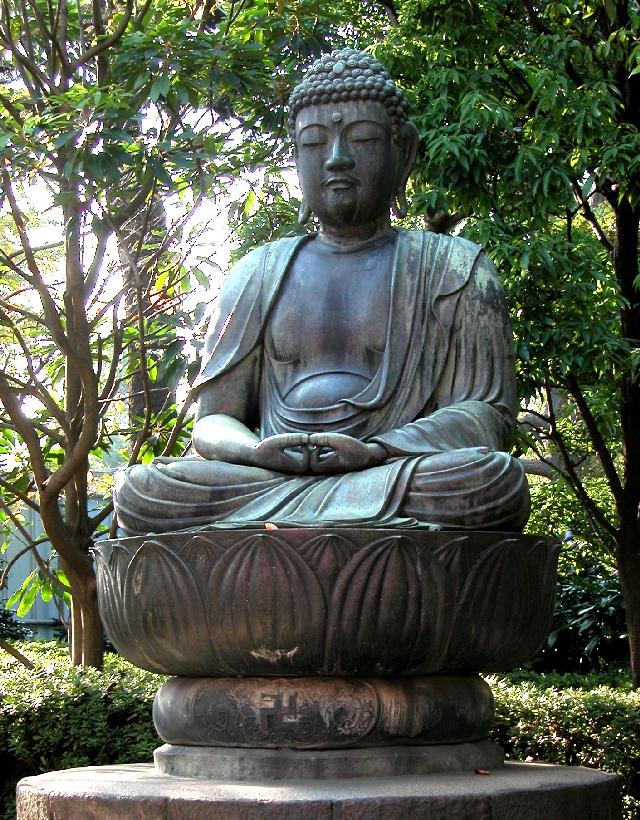
Buddhism

Buddha's life and Buddhist History:
Buddha's given name was Siddhartha Gautama, he was the son of a local king in Kapilavastu
(on the Indian-Nepalese border) around the 5th century BCE. Buddhist history
recounts that soothsayers predicted the prince would become either a
Chakravartin (universal monarch) or an "awakened one," a buddha.
Siddhartha being privileged and wealthy, had a comfortable upbringing.
During his late twenties, Siddhartha is said to have encountered "four signs"
which altered his life forever. These signs were: an old man, a sick man, a corpse, and a monk or a
yogin (i.e. yoga or yogin refer to a man who pursues and/or teaches various
religious practices). Buddha is said to have asserted that youth, health, and even life come to an
end, and that one must leave the suffering world of Saṃsāra (i.e., the cycle of
rebirth and suffering. More generally, the cycle of birth, life, death,
and rebirth) by finding and following the right spiritual path.
At twenty-nine, Siddhartha, a father himself, left the palace and kingdom to
become a homeless, wandering yogi. He began to practice as a pupil of two ascetic teachers, Arada Kalama and Rudraka Ramaputra.
Siddhartha eventually became Buddha Shakyamuni, who with his disciples first
practiced Buddhism in the middle of the 6th to the middle of the 5th centuries
B.C.E. (before the common era). During the 3rd century B.C.E. Buddhism
grew within India and began to spread outside its borders. Buddhism began to
spread through the various countries of Asia throughout the 2nd century B.C.E.
For instance, there are some reports of Buddhists in China in the 3rd century,
though no one actively propagated Buddhism until the early centuries of the
Common era. The tradition story alleges that the Han emperor Ming Ti (AD
57/58-75/76) dreamt of a flying golden deity, which was interpreted as a Buddha.
Ming Ti acted on his vision and obtained a copy of the Sūtra (i.e., the
canonical collection of aphorisms thought to represent the oral teachings of
Budda), which he placed in a temple near Lo-yang, the capital.
Historical research shows that Buddhism spread through China gradually, primarily through Central Asia
and later by trade routes around and through Southeast Asia.
God/Gods:
Buddhism recognizes no supreme creator god. Buddha, "the Awakened One," is revered above all as
a fully human religious sage and completely enlightened person.
Origin of Universe and Life:
Scientists to explain origins of the universe and life.
After Death:
Reincarnation a journey of rebirths to reach Nirvana: Rebirth through the law of
karma. During life an individual's good and bad intentions become imprinted in their
mind. Negative intentions persist through reincarnations until the individual's intentions become wholesome. Once
the individual's mind becomes bereft of bad intentions, they become fully
enlightened. Enlightenment brings a liberation from rebirths through the
attainment of a state of absolute selflessness and ultimate bliss called Nirvana,
or the "Deathless State." One then becomes Buddha (or one with Buddha). Some Buddhists, especially modern
Western Buddhists deemphasize believe in literal rebirth.
Is there Evil in the World, and Why?
Evils exists as the result of every individual's free will. Specifically,
evil results bad intentions such as egoism, cravings, attachments, and ignorance are expressed as greed, hatred, and
violence. This evil in the form of suffering follows an individual through
rebirth. The cessation of this suffering through the attainment of nirvana
is the primary goal of Buddhism.
Central Doctrines:
The Three Trainings or Practices:
1. Sila (ethics) This is based on two fundamental principles:
The principle of equality: that all living entities are equal.
The principle of reciprocity
2. Samadhi (mental discipline): Concentration, meditation, mental development. Developing one's mind is the path to wisdom which in turn leads to personal freedom. Mental development also strengthens and controls our mind; this helps us maintain good conduct.
3. Prajna (wisdom): Discernment, insight, wisdom, and enlightenment emerges
from a pure and calm mind.
The Four Noble Truths:
1. Dukkha: Suffering is real and universal in life.
2. Samudaya: The cause of suffering is a desire to have and control transient things,
such as physical objects, affections, ideas.
3. Nirodha: Nirvana, the complete freedom, liberation and non-attachment ends
suffering.
4. Magga: The eightfold path leads to the cessation of suffering.
Buddhist Sites: